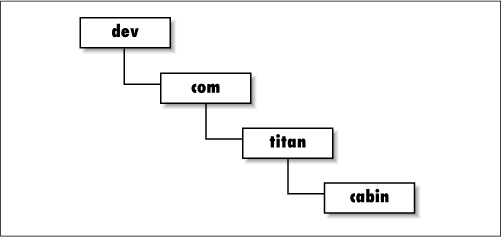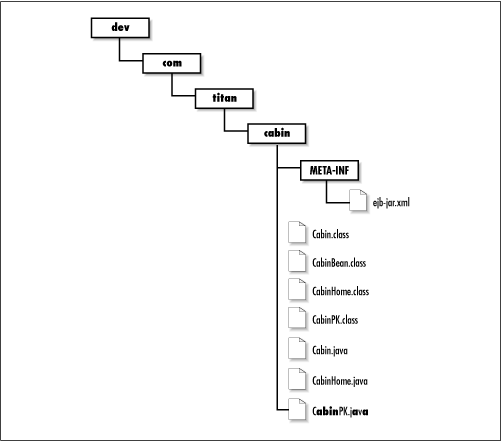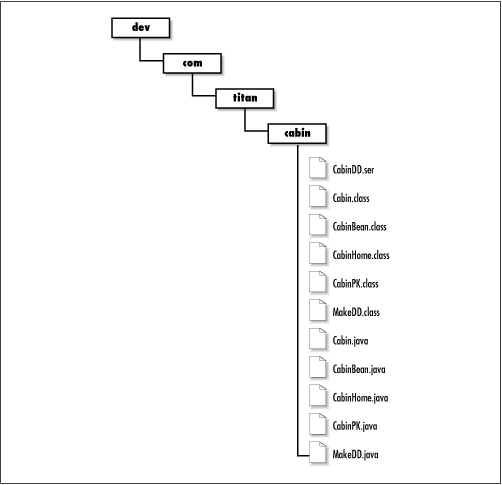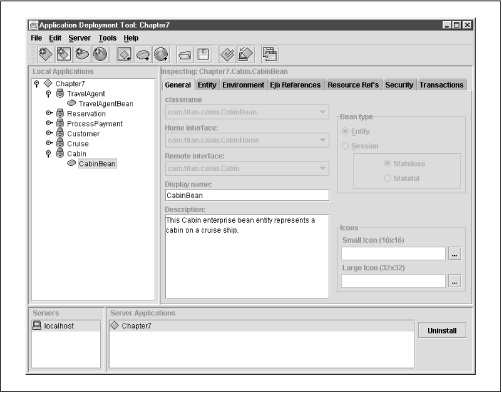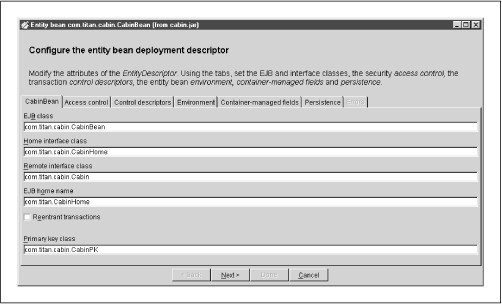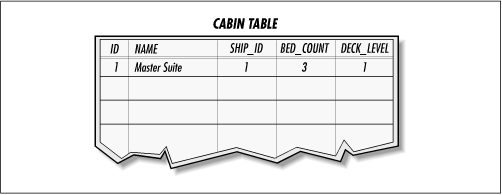



|

Enterprise Java Beans: Developing Your First Enterprise Beans Reproduced with kind permision of O'Reilly & Associates: www.oreilly.com
Choosing and Setting Up an EJB Server One of the most important features of EJB is that beans should work with containers from different vendors. That doesn't mean that selecting a server and installing your beans on that server are trivial processes. We'll start this chapter with a general discussion of how you select and set up a server. The EJB server you choose should be compliant with the EJB 1.0 or EJB 1.1 specification. However, in the EJB 1.0 version of the specification, support for entity beans and container-managed persistence is optional. In EJB 1.1, support for entity beans is required. The first example in this chapter--and most of the examples in this book--assume that your EJB server supports entity beans and container-managed persistence.[1] The EJB server you choose should also provide a utility for deploying an enterprise bean. It doesn't matter whether the utility is command-line oriented or graphical, as long as it does the job. The deployment utility should allow you to work with prepackaged enterprise beans, i.e., beans that have already been developed and archived in a JAR file. Finally, the EJB server should support an SQL-standard relational database that is accessible using JDBC. For the database, you should have privileges sufficient for creating and modifying a few simple tables in addition to normal read, update, and delete capabilities. If you have chosen an EJB server that does not support an SQL standard relational database, you may need to modify the examples to work with the product you are using. Setting Up Your Java IDE To get the most from this chapter, it helps to have an IDE that has a debugger and allows you to add Java files to its environment. Several Java IDEs, like Symantec's Visual Cafe, IBM's VisualAge, Inprise's JBuilder, and Sun's Forte, fulfill this simple requirement. The debugger is especially important because it allows you to walk slowly through your client code and observe how the EJB client API is used. Once you have an IDE set up, you need to include the Enterprise JavaBeans packages. These packages include javax.ejb and for EJB 1.0 javax.ejb.deployment. You also need the JNDI packages, including javax.naming, javax.naming.directory, and javax.naming.spi. In addition, you will need the javax.rmi package for EJB 1.1. All these packages can be downloaded from Sun's Java site (https://www.javasoft.com) in the form of ZIP or JAR files. They may also be accessible in the subdirectories of your EJB server, normally under the lib directory. There seems to be no better place to start than the Cabin bean, which we have been examining throughout the previous chapters. The Cabin bean is an entity bean that encapsulates the data and behavior associated with a real-world cruise ship cabin in Titan's business domain. Cabin: The Remote Interface When developing an entity bean, we first want to define the bean's remote interface. The remote interface defines the bean's business purpose; the methods of this interface must capture the concept of the entity. We defined the remote interface for the Cabin bean in Chapter 2; here, we add two new methods for setting and getting the ship ID and the bed count. The ship ID identifies the ship that the cabin belongs to, and the bed count tells how many people the cabin can accommodate.
package com.titan.cabin;
import java.rmi.RemoteException;
public interface Cabin extends javax.ejb.EJBObject {
public String getName() throws RemoteException;
public void setName(String str) throws RemoteException;
public int getDeckLevel() throws RemoteException;
public void setDeckLevel(int level) throws RemoteException;
public int getShip() throws RemoteException;
public void setShip(int sp) throws RemoteException;
public int getBedCount() throws RemoteException;
public void setBedCount(int bc) throws RemoteException;
}
The Cabin interface defines four properties: the name, deckLevel, ship, and bedCount. Properties are attributes of a bean that can be accessed by public set and get methods. The methods that access these properties are not explicitly defined in the Cabin interface, but the interface clearly specifies that these attributes are readable and changeable by a client. Notice that we have made the Cabin interface a part of a new package named com.titan.cabin. In this book, we place all the classes and interfaces associated with each type of bean in a package specific to the bean. Because our beans are for the use of the Titan cruise line, we place these packages in the com.titan package hierarchy. We also create directory structures that match package structures. If you are using an IDE that works directly with Java files, create a new directory somewhere called dev (for development) and create the directory structure shown in Figure 4-1. Copy the Cabin interface into your IDE and save its definition to the cabin directory. Compile the Cabin interface to ensure that its definition is correct. The Cabin.class file, generated by the IDE's compiler, should be written to the cabin directory, the same directory as the Cabin.java file.
CabinHome: The Home Interface Once we have defined the remote interface of the Cabin bean, we have defined the world's view of this simple entity bean. Next, we need to define the Cabin bean's home interface, which specifies how the bean can be created, located, and destroyed; in other words, the Cabin bean's life-cycle behavior. Here is a complete definition of the CabinHome home interface:
package com.titan.cabin;
import java.rmi.RemoteException;
import javax.ejb.CreateException;
import javax.ejb.FinderException;
public interface CabinHome extends javax.ejb.EJBHome {
public Cabin create(int id)
throws CreateException, RemoteException;
public Cabin findByPrimaryKey(CabinPK pk)
throws FinderException, RemoteException;
}
The CabinHome interface extends the
javax.ejb.EJBHome and defines two life- cycle
methods: create() and findByPrimaryKey(). These methods create and locate Cabin
beans. Remove methods (for deleting beans) are defined in the javax.ejb.EJBHome interface, so the CabinPK: The Primary Key The CabinPK is the primary key class of the Cabin bean. All entity beans must have a serializable primary key that can be used to uniquely identify an entity bean in the database. Here is the class definition of the CabinPK primary key:
package com.titan.cabin;
public class CabinPK implements java.io.Serializable {
public int id;
public int hashCode() {
return id;
}
public boolean equals(Object obj) {
if (obj instanceof CabinPK) {
return (id == ((CabinPK)obj).id);
}
return false;
}
}
The primary key belongs to the CabinBean: The Bean Class You have now defined the complete client-side API for creating, locating, removing, and using the Cabin bean. Now we need to define CabinBean, the class that provides the implementation on the server for the Cabin bean. The CabinBean class is an entity bean that uses container-managed persistence, so its definition will be fairly simple. In addition to the callback methods discussed in Chapters and , we must also define EJB implementations for most of the methods defined in the Cabin and CabinHome interfaces. Here is the complete definition of the CabinBean class in EJB 1.1:
// EJB 1.1 CabinBean
package com.titan.cabin;
import javax.ejb.EntityContext;
public class CabinBean implements javax.ejb.EntityBean {
public int id;
public String name;
public int deckLevel;
public int ship;
public int bedCount;
public CabinPK ejbCreate(int id) {
this.id = id;
return null;
}
public void ejbPostCreate(int id) {
// Do nothing. Required.
}
public String getName() {
return name;
}
public void setName(String str) {
name = str;
}
public int getShip() {
return ship;
}
public void setShip(int sp) {
ship = sp;
}
public int getBedCount() {
return bedCount;
}
public void setBedCount(int bc) {
bedCount = bc;
}
public int getDeckLevel() {
return deckLevel;
}
public void setDeckLevel(int level ) {
deckLevel = level;
}
public void setEntityContext(EntityContext ctx) {
// Not implemented.
}
public void unsetEntityContext() {
// Not implemented.
}
public void ejbActivate() {
// Not implemented.
}
public void ejbPassivate() {
// Not implemented.
}
public void ejbLoad() {
// Not implemented.
}
public void ejbStore() {
// Not implemented.
}
public void ejbRemove() {
// Not implemented.
}
}
And here's the CabinBean class for EJB 1.0. It differs only in the return value of ejbCreate():
// EJB 1.0 CabinBean
import javax.ejb.EntityContext;
public class CabinBean implements javax.ejb.EntityBean {
public int id;
public String name;
public int deckLevel;
public int ship;
public int bedCount;
public void ejbCreate(int id) {
this.id = id;
}
public void ejbPostCreate(int id) {
// Do nothing. Required.
}
public String getName() {
return name;
}
public void setName(String str) {
name = str;
}
public int getShip() {
return ship;
}
public void setShip(int sp) {
ship = sp;
}
public int getBedCount() {
return bedCount;
}
public void setBedCount(int bc) {
bedCount = bc;
}
public int getDeckLevel() {
return deckLevel;
}
public void setDeckLevel(int level ) {
deckLevel = level;
}
public void setEntityContext(EntityContext ctx) {
// Not implemented.
}
public void unsetEntityContext() {
// Not implemented.
}
public void ejbActivate(){
// Not implemented.
}
public void ejbPassivate(){
// Not implemented.
}
public void ejbLoad(){
// Not implemented.
}
public void ejbStore(){
// Not implemented.
}
public void ejbRemove(){
// Not implemented.
}
}
The CabinBean class belongs to the com.titan.cabin package, just like the interfaces and primary key class. The CabinBean class can be divided into four sections for discussion: declarations for the container-managed fields, the ejbCreate() methods, the callback methods, and the remote interface implementations. Declared fields in a bean class can be persistent fields and property fields. These categories are not mutually exclusive. The persistent field declarations describe the fields that will be mapped to the database. A persistent field is often a property (in the JavaBeans sense): any attribute that is available using public set and get methods. Of course, a bean can have any fields that it needs; they need not all be persistent, or properties. Fields that aren't persistent won't be saved in the database. In CabinBean, all the fields are persistent. The id field is persistent, but it is not a property. In other words, id is mapped to the database but cannot be accessed through the remote interface. The primary key, CabinPK, also contains an integer field called id, just like the CabinBean. This means that the primary key for the CabinBean is its id field because the signatures match. The name, deckLevel, ship, and bedCount fields are persistent fields. They will be mapped to the database at deployment time. These fields are also properties because they are publicly available through the remote interface. In the case of the Cabin bean, there was only one create() method, so there is only one corresponding ejbCreate() method and one ejbPostCreate() method, which is shown in both the EJB 1.1 and EJB 1.0 listings. When a client invokes a method on the home interface, it is delegated to a matching ejbCreate() method on the bean instance. The ejbCreate() method initializes the fields; in the case of the CabinBean, it sets the id field to equal the passed integer. In the case of EJB 1.0, the Once the ejbCreate() method has
executed, the ejbPostCreate() method is called to
perform any follow-up operations. The ejbCreate()
and ejbPostCreate() methods must have signatures
that match the parameters and (optionally) the exceptions of the home
interface's create() method. However, ejbCreate() and The findByPrimaryKey() method is not defined in container-managed bean classes. With container-managed beans you do not explicitly declare find methods in the bean class. Instead, find methods are generated at deployment and implemented by the container. With bean-managed beans (beans that explicitly manage their own persistence), find methods must be defined in the bean class. Our Cabin bean is a container-managed bean, so we will not need to define its find method. In Chapter 6, when you develop bean-managed entity beans, you will define the find methods in the bean classes you develop. The business methods in the CabinBean match the signatures of the business methods defined in the remote interface. These include getName(), setName(), getDeckLevel(), setDeckLevel(), getShip(), setShip(), getBedCount(), and setBedCount(). When a client invokes one of these methods on the remote interface, the method is delegated to the matching method on the bean class. Again, the business methods do not throw the RemoteException like the matching methods in the remote interface. In both the ejbCreate() and remote interface methods, it is possible to define application or custom exceptions. If a custom exception is defined, both the interface method and its matching method in the bean class must throw it. We will learn more about custom exceptions in Chapter 6. The entity context methods are responsible for setting and unsetting the EntityContext. The EntityContext is an interface implemented by the EJB container that provides the bean with information about the container, the identity of the client, transactional control, and other environmental information if the bean needs it. Because the Cabin bean is a very simple container-managed bean, this example does not use the EntityContext. Subsequent examples in Chapter 6 will make good use of the EntityContext. The CabinBean class implements javax.ejb.EntityBean, which defines five callback methods: ejbActivate(), ejbPassivate(), ejbLoad(), ejbStore(), and ejbRemove(). The container uses these callback methods to notify the CabinBean of certain events in its life cycle. Although the callback methods are implemented, the implementations are empty. The CabinBean is simple enough that it doesn't need to do any special processing during its life cycle. When we study entity beans in more detail in Chapter 6, we will take advantage of these callback methods. That's enough talk about the CabinBean definition. Now that you are familiar with it, copy it to your IDE, save it to the cabin directory as CabinBean.java, and compile it. You are now ready to create a deployment descriptor for the Cabin bean. The deployment descriptor performs a function similar to a properties file. It describes which classes make up a bean and how the bean should be managed at runtime. During deployment, the deployment descriptor is read and its properties are displayed for editing. The deployer can then modify and add settings as appropriate for the application's operational environment. Once the deployer is satisfied with the deployment information, he or she uses it to generate the entire supporting infrastructure needed to deploy the bean in the EJB server. This may include adding the bean to the naming system and generating the bean's EJB object and EJB home, persistence infrastructure, transactional support, resolving bean references, and so forth. Although most EJB server products provide a wizard for creating and editing deployment descriptors, we will create ours directly so that the bean is defined in a vendor-independent manner. This requires some manual labor, but it gives you a much better understanding of how deployment descriptors are created. Once the deployment descriptor is finished, the bean can be placed in a JAR file and deployed on any EJB-compliant server of the appropriate version. EJB 1.1: The Deployment Descriptor An XML deployment descriptor for every example in this book has already been created and is available from the download site. If you haven't downloaded the examples, do so now. The examples are packaged in a ZIP file and organized by chapter and bean, so you will need to put the ejb-jar.xml file from the directory chapter4/EJB11/com/titan/cabin in the ZIP file. When you create the JAR file to deploy the Cabin bean, this ejb-jar.xml file must be in the JAR as META-INF/ejb-jar.xml in order for it to be found. If it has any other name or any other location, this deployment descriptor will not be used. Here's a quick peek at the deployment descriptor for the Cabin bean, so you can get a feel for how an XML deployment descriptor is structured and the type of information it contains:
<?xml version="1.0"?>
<!DOCTYPE ejb-jar PUBLIC "-//Sun Microsystems, Inc.//DTD Enterprise
JavaBeans 1.1//EN" "https://java.sun.com/j2ee/dtds/ejb-jar_1_1.dtd">
<ejb-jar>
<enterprise-beans>
<entity>
<description>
This Cabin enterprise bean entity represents a cabin on
a cruise ship.
</description>
<ejb-name>CabinBean</ejb-name>
<home>com.titan.cabin.CabinHome</home>
<remote>com.titan.cabin.Cabin</remote>
<ejb-class>com.titan.cabin.CabinBean</ejb-class>
<persistence-type>Container</persistence-type>
<prim-key-class>com.titan.cabin.CabinPK</prim-key-class>
<reentrant>False</reentrant>
<cmp-field><field-name>id</field-name></cmp-field>
<cmp-field><field-name>name</field-name></cmp-field>
<cmp-field><field-name>deckLevel</field-name></cmp-field>
<cmp-field><field-name>ship</field-name></cmp-field>
<cmp-field><field-name>bedCount</field-name></cmp-field>
</entity>
</enterprise-beans>
<assembly-descriptor>
<security-role>
<description>
This role represents everyone who is allowed full access
to the cabin bean.
</description>
<role-name>everyone</role-name>
</security-role>
<method-permission>
<role-name>everyone</role-name>
<method>
<ejb-name>CabinBean</ejb-name>
<method-name>*</method-name>
</method>
</method-permission>
<container-transaction>
<method>
<ejb-name>CabinBean</ejb-name>
<method-name>*</method-name>
</method>
<trans-attribute>Required</trans-attribute>
</container-transaction>
</assembly-descriptor>
</ejb-jar>
The <!DOCTYPE> element describes the purpose of the XML file, its root element, and the location of its DTD. The DTD is used to verify that the document is structured correctly. This element is discussed in detail in Chapter 10 and is not important to understanding this example. The rest of the elements are nested one within the other and are delimited by a beginning tag and ending tag. The structure is really not very complicated. If you have done any HTML coding you should already understand the format. An element always starts with <name of tag > tag and ends with </name of tag > tag. Everything in between--even other elements--is part of the enclosing element. The first major element is the <ejb-jar> element, which is the root of the document. All the other elements must lie within this element. Next is the <enterprise-beans> element. Every bean declared in an XML file must be included in this section. This file only describes the Cabin bean, but we could define several beans in one deployment descriptor. The <entity> element shows that the beans defined within this tag are entity beans. Similarly, a <session> element describes session beans; since the Cabin bean is an entity bean, we don't need a <session> element. In addition to a description, the <entity> element provides the fully qualified class names of the remote interface, home interface, bean class, and primary key. The <cmp-field> elements list all the container-managed fields in the entity bean class. These are the fields that will be persisted in the database and are managed by the container at runtime. The <entity> element also includes a <reentrant> element that can be set as True or False depending on whether the bean allows reentrant loopbacks or not. The next section of the XML file, after the <enterprise-bean> element, is enclosed by the <assembly-descriptor> element, which describes the security roles and transactional attributes of the bean. It may seem odd to separate this information from the <enterprise-beans> element, since it clearly applies to the Cabin bean, but in the scheme of things it's perfectly natural. An XML deployment descriptor can describe several beans, which might all rely on the same security roles and transactional attributes. To make it easier to deploy several beans together, all this common information is separated into the <assembly-descriptor> element. There is another reason (perhaps a more important reason) for separating information about the bean itself from the security roles and transactional attributes. The EJB 1.1 specification clearly defines the responsibilities of different participants in the development and deployment of beans. We don't address these development roles in this book because they are not critical to learning the fundamentals of EJB. For now, it's enough to know that the person who develops the bean and the person who assembles the beans into an application have separate responsibilities and therefore separate parts of the XML deployment descriptor. The bean developer is responsible for everything within the <enterprise-beans> element; the bean assembler is responsible for everything within the <assembly-descriptor>. In our example, we're playing both roles, developing the beans and assembling them. But in real life, you might buy a set of beans developed by a third-party vendor, who would have no idea how you intend to use the beans, what your security requirements are, etc. The <assembly-descriptor> contains the <security-role> elements and their corresponding <method-permission> elements, which were described in Chapter 3 under "Security." In this example there is one security role, everyone, which is mapped to all the methods in the Cabin bean using the <method-permission> element. (The * in the <method-name> element means "all methods"). The container-transaction element declares that all the methods of the Cabin bean have a Required transactional attribute. Transactional attributes are explained in more detail in Chapter 8, but for now it means that all the methods must be executed within a transaction. The deployment descriptor ends with the enclosing tab of the <ejb-jar> element. Copy the Cabin bean's deployment descriptor into the same directory as the class files for the Cabin bean files (Cabin.class, CabinHome.class, CabinBean.class, and CabinPK.class) and save it as ejb-jar.xml. You have now created all the files you need to package your EJB 1.1 Cabin bean. Figure 4-2 shows all the files that should be in the cabin directory.
EJB 1.0: The Deployment Descriptor Here is a Java application that instantiates, populates, and serializes a DeploymentDescriptor for the EJB 1.0 Cabin bean:
package com.titan.cabin;
import javax.ejb.deployment.EntityDescriptor;
import javax.ejb.deployment.ControlDescriptor;
import javax.naming.CompoundName;
import com.titan.cabin.CabinBean;
import java.util.Properties;
import java.io.FileOutputStream;
import java.io.ObjectOutputStream;
import java.lang.reflect.Field;
public class MakeDD {
public static void main(String [] args) {
try {
if (args.length <1){
System.out.println("must specify target directory");
return;
}
EntityDescriptor cabinDD = new EntityDescriptor();
cabinDD.setEnterpriseBeanClassName("com.titan.cabin.CabinBean");
cabinDD.setHomeInterfaceClassName("com.titan.cabin.CabinHome");
cabinDD.setRemoteInterfaceClassName("com.titan.cabin.Cabin");
cabinDD.setPrimaryKeyClassName("com.titan.cabin.CabinPK");
Class beanClass = CabinBean.class;
Field [] persistentFields = new Field[5];
persistentFields[0] = beanClass.getDeclaredField("id");
persistentFields[1] = beanClass.getDeclaredField("name");
persistentFields[2] = beanClass.getDeclaredField("deckLevel");
persistentFields[3] = beanClass.getDeclaredField("ship");
persistentFields[4] = beanClass.getDeclaredField("bedCount");
cabinDD.setContainerManagedFields(persistentFields);
cabinDD.setReentrant(false);
CompoundName jndiName = new CompoundName("CabinHome",
new Properties());
cabinDD.setBeanHomeName(jndiName);
ControlDescriptor cd = new ControlDescriptor();
cd.setIsolationLevel(ControlDescriptor.TRANSACTION_READ_COMMITTED);
cd.setTransactionAttribute(ControlDescriptor.TX_REQUIRED);
cd.setRunAsMode(ControlDescriptor.CLIENT_IDENTITY);
cd.setMethod(null);
ControlDescriptor [] cdArray = {cd};
cabinDD.setControlDescriptors(cdArray);
String fileSeparator =
System.getProperties().getProperty("file.separator");
if (! args[0].endsWith(fileSeparator))
args[0] += fileSeparator;
FileOutputStream fos = new FileOutputStream(args[0]+"CabinDD.ser");
ObjectOutputStream oos = new ObjectOutputStream(fos);
oos.writeObject(cabinDD);
oos.flush();
oos.close();
fos.close();
} catch (Throwable t) { t.printStackTrace();}
}
}
Copy this definition into your IDE, save it in the cabin directory, and compile it. When you run the application, MakeDD, use the path to the cabin directory, where all the other Cabin bean files are stored, as a command-line parameter:
\dev % java com.titan.cabin.MakeDD com/titan/cabin
F:\..\dev>java com.titan.cabin.MakeDD com\titan\cabin
If you run this application, you should end up with a file called CabinDD.ser in the com/titan/cabin directory. This is your serialized DeploymentDescriptor for the Cabin bean. Now that you know that the application works properly, let's look at it in more detail. We begin with the creation of the EntityDescriptor:
EntityDescriptor cabinDD = new EntityDescriptor();
An entity descriptor is a DeploymentDescriptor that has been extended to support entity beans. If we were creating a DeploymentDescriptor for a session bean, we would use the SessionDescriptor subclass. Notice that we are not extending EntityDescriptor to create a special cabin DeploymentDescriptor. We are using the EntityDescriptor class provided by the EJB package javax.ejb.deployment. The EntityDescriptor describes the classes and interfaces used by the Cabin bean. The next section of code sets the names of the bean class, the home interface, the remote interface, and the primary key. All of these set methods are defined in the EntityDescriptor's superclass, DeploymentDescriptor, except for setPrimaryKeyClassName(); this method is defined in the EntityDescriptor class.
cabinDD.setEnterpriseBeanClassName("com.titan.cabin.CabinBean");
cabinDD.setHomeInterfaceClassName("com.titan.cabin.CabinHome");
cabinDD.setRemoteInterfaceClassName("com.titan.cabin.Cabin");
cabinDD.setPrimaryKeyClassName("com.titan.cabin.CabinPK");
When the bean is deployed, the deployment tools will read these properties so that the tools can locate the bean interfaces and primary key class and generate all the supporting code, such as the EJB object and EJB home. The next section is a little more complicated. Our Cabin bean is going to be a container-managed entity bean, which means that the container will automatically handle persistence. To handle persistence, the container must know which of the CabinBean's fields it is responsible for. Earlier, it was decided that the id, name, deckLevel, ship, and bedCount fields were all persistent fields in the CabinBean. The following code tells the EntityDescriptor that these fields are container managed by using the Reflection API to pass an array of Field objects to setContainerManagedFields():
Class beanClass = CabinBean.class;
Field [] persistentFields = new Field[5];
persistentFields[0] = beanClass.getDeclaredField("id");
persistentFields[1] = beanClass.getDeclaredField("name");
persistentFields[2] = beanClass.getDeclaredField("deckLevel");
persistentFields[3] = beanClass.getDeclaredField("ship");
persistentFields[4] = beanClass.getDeclaredField("bedCount");
cabinDD.setContainerManagedFields(persistentFields);
Although the code tells the EntityDescriptor which fields are container- managed, it doesn't describe how these fields will map to the database. The actual mapping of the fields to the database depends on the type of database and on the EJB server used. The mapping is vendor- and database-dependent, so we won't worry about it just now. When the bean is actually deployed in some EJB server, the deployer will map the container-managed fields to whatever database is used. The next line tells the EntityDescriptor that the Cabin bean is nonreentrant. We discussed the problems associated with reentrant beans in Chapter 3. Entity beans are not reentrant by default, but it never hurts to make this explicit.
cabinDD.setReentrant(false);
The following code uses the JNDI API to set the lookup name of the bean in the EJB server's directory structure. In Chapter 3, we saw that Enterprise JavaBeans requires servers to support the use of JNDI for organizing beans in a directory structure. Later, when we create a client application, the name we assign to the Cabin bean will be used to locate and obtain a remote reference to the bean's EJB home.
CompoundName jndiName = new CompoundName("CabinHome", new Properties());
cabinDD.setBeanHomeName(jndiName);
We have created a directory entry that places the bean under the name CabinHome. Although it makes sense to assign names that reflect the organization of your beans, you can give the EJB home any lookup name you like. We could have used other names assigned to the Cabin bean, like HomeCabin or just cabin. Next, we create a ControlDescriptor to set the bean's transactional and security attributes:
ControlDescriptor cd = new ControlDescriptor();
cd.setIsolationLevel(ControlDescriptor.TRANSACTION_READ_COMMITTED);
cd.setTransactionAttribute(ControlDescriptor.TX_REQUIRED);
cd.setRunAsMode(ControlDescriptor.CLIENT_IDENTITY);
cd.setMethod(null);
ControlDescriptor [] cdArray = {cd};
cabinDD.setControlDescriptors(cdArray);
After creating the ControlDescriptor,
we set its transactional attributes. This includes setting the transactional
context and isolation level. Transactions are fairly complicated and are
discussed in detail in Chapter 8. Essentially, we are saying that the bean
must be executed in a transaction and that the bean is not accessible by any
other client while executing a transaction. Next, we set the runAs mode of the
bean. The runAs mode determines how the bean's methods will execute at
runtime. In this case, the methods will be executed under the identity that
invoked the bean. This means that any other beans or resources accessed by the
method will be validated based on the client's identity. Then we set the
methods that the ControlDescriptor represents and
add the ControlDescriptor to the EntityDescriptor. Here we set the method to null, which means that the Finally, we serialize the EntityDescriptor with all its Cabin bean properties to a file called CabinDD.ser. This serialized EntityDescriptor should be saved to the same directory that holds all the other files for the Cabin bean, the dev/com/titan/cabin directory.
String fileSeparator = System.getProperties().getProperty("file.separator");
if (! args[0].endsWith(fileSeparator))
args[0] += fileSeparator;
FileOutputStream fos = new FileOutputStream(args[0]+"CabinDD.ser");
ObjectOutputStream oos = new ObjectOutputStream(fos);
oos.writeObject(cabinDD);
oos.flush();
oos.close();
fos.close();
The first part of the serialization section simply determines whether the path ends with a file separator for that operating system. If it doesn't, the code adds one. The second part serializes the deployment descriptor to a file called CabinDD.ser in the directory passed in at the command line. You have now created everything you need to package your EJB 1.0 Cabin bean for deployment. Figure 4-3 shows all the files that should be in the cabin directory.
cabin.jar: The JAR File The JAR file is a platform-independent file format for compressing, packaging, and delivering several files together. Based on ZIP file format and the ZLIB compression standards, the JAR ( Java archive) packages and tool were originally developed to make downloads of Java applets more efficient. As a packaging mechanism, however, the JAR file format is a very convenient way to "shrink-wrap" components and other software for delivery to third parties. The original JavaBeans component architecture depends on JAR files for packaging, as does Enterprise JavaBeans. The goal in using the JAR file format in EJB is to package all the classes and interfaces associated with a bean, including the deployment descriptor into one file. The process of creating an EJB JAR file is slightly different between EJB 1.1 and EJB 1.0. EJB 1.1: Packaging the Cabin bean Now that you have put all the necessary files in one directory, creating the JAR file is easy. Position yourself in the dev directory that is just above the com/titan/cabin directory tree, and execute the command:
\dev % jar cf cabin.jar com/titan/cabin/*.class META-INF/ejb-jar.xml
F:\..\dev>jar cf cabin.jar com\titan\cabin\*.class META-INF\ejb-jar.xml
You might have to create the META-INF directory first and copy ejb-jar.xml into that directory. The c option tells the jar utility to create a new JAR file that contains the files indicated in subsequent parameters. It also tells the jar utility to stream the resulting JAR file to standard output. The f option tells jar to redirect the standard output to a new file named in the second parameter (cabin.jar) . It's important to get the order of the option letters and the command-line parameters to match. You can learn more about the jar utility and the java.util.zip package in Java? in a Nutshell by David Flanagan, or Learning Java? (formerly Exploring ?), by Pat Niemeyer and Jonathan Knudsen (both published by O'Reilly). The jar utility creates the file cabin.jar in the dev directory. If you're interested in looking at the contents of the JAR file, you can use any standard ZIP application (WinZip, PKZIP, etc.), or you can use the command jar tvf cabin.jar. EJB 1.0: Packaging the Cabin bean In addition to the bean's classes and deployment descriptor, the JAR file contains a manifest generated by the jar utility. The manifest essentially serves as a README file, describing the contents in a way that's useful for any tools that work with the archive. We need to add an entry into the JAR file to specify which file contains our serialized deployment descriptor. To do this, we add two simple lines to the manifest by creating an ASCII text file named manifest :
Name: com/titan/cabin/CabinDD.ser
Enterprise-Bean: True
That's it! When we run the jar utility, we will tell it to use our manifest information when it build the JAR. The manifest for this bean is now complete. A manifest is always organized as a set of name-value pairs that describe the files in the JAR file. In this case, we need to point to the location of the serialized deployment descriptor and define the JAR as an EJB JAR. The first line points to the serialized EntityDescriptor, CabinDD.ser, for the Cabin bean. Notice that forward slashes ("/") must be used as path separators; this could be confusing if you are used to the Windows environment. The next line of the manifest identifies the JAR as an EJB JAR. Most EJB server deployment tools check for this name-value pair before trying to read the JAR file's contents. Save the manifest in the cabin directory where all the other Cabin bean files are located. It should be saved as the file name manifest with no extension. Now that you have put all the necessary files in one directory, creating the JAR file is easy. Position yourself in the dev directory that is just above the com/titan/cabin directory tree, and execute the following command:
\dev % jar cmf com/titan/cabin/manifest cabin.jar com/titan/cabin/*.class \
com/titan/cabin/*.ser
F:\..\dev>jar cmf com\titan\cabin\manifest cabin.jar com\titan\cabin\*.class
com\titan\cabin\*.ser
If you want, you may remove the MakeDD.class file from the JAR archive, since it's not a standard EJB class and the EJB deployment tools do not use it. Leaving it there will not impact deployment of the Cabin bean. Creating a CABIN Table in the Database One of the primary jobs of a deployment tool is mapping entity beans to databases. In the case of the Cabin bean, we must map its id, name, deckLevel, ship, and bedCount (the bean's container-managed fields) to some data source. Before proceeding with deployment, you need to set up a database and create a CABIN table. You can use the following standard SQL statement to create a CABIN table that will be consistent with the examples provided in this chapter:
create table CABIN
(
ID int primary key,
SHIP_ID int,
BED_COUNT int,
NAME char(30),
DECK_LEVEL int
)
This statement creates a CABIN table that has five columns corresponding to the container-managed fields in the CabinBean class. Once the table is created and connectivity to the database is confirmed, you can proceed with the deployment process. |

